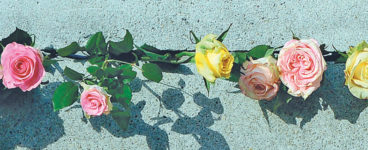‘Outside, birch and alder saplings were establishing themselves. In between them, stands of foxgloves had sprouted, their bugle-shaped flowers turning from white to pink.’
We may not be able to go wandering too far from home just now, but we can still be armchair travellers, especially with books as evocative as Patrick Baker’s The Unremembered Places: Exploring Scotland’s Wild Histories. In this extract, he invites us to travel round Scotland’s western isles.
Extract taken from The Unremembered Places: Exploring Scotland’s Wild Histories
By Patrick Baker
Published by Birlinn Ltd
Of all of Scotland’s wild places, its wild islands enthral me the most. Perhaps it’s some relic from childhood. The consequence of reading so many children’s books that imbued islands with a sense of mystery and adventure. They were the realms of exploit and exploration, wondrous territories described in a tantalising prose of danger and discovery. Places such as Robert Louis Stevenson’s Treasure Island, that could claim ‘latitude and longitude, soundings, names of hills and bays and inlets, and every particular that would be needed to bring a ship to safe anchorage’. To a child’s mind they also represented powerful notions of independence and freedom, distanced both physically and imaginatively from the timeframes and rules of the adult world. Most famously, in Arthur Ransome’s Swallows and Amazons, Wild Cat Island becomes a private dominion for the children of the novel: their own unexplored island kingdom, to be mapped, named and ruled over by them, as if they are the first to ever land on its shores.
There is, then, something childlike in my fascination with wild islands, but there is also something inherently beguiling about their separateness. Their geographical detachment from the mainland and the difficulty to reach them provokes the same stubborn inquisitiveness in me as remote mountain peaks do. They are also, as I have come discover over the years, places that have been repeatedly weighted with human importance, invested with strategic or spiritual significance through multiple generations.
I have visited dozens of Scotland’s wild islands, but there are countless more I have never set foot on. Many are cast out at sea, but it is the inland varieties that really capture my imagination: wooded islets, freshwater archipelagos or tide-marked outcrops sheltered in sea lochs. None are lived upon (for to be truly wild, an island must be uninhabited) and unlike other wilderness areas, few attract much human traffic. In their containment and isolation they have become vessels of past events, water-locked archives for some of Scotland’s wildest histories.
I had in mind to extend my exploration of wild islands further. For some time, I had heard of a cluster of islands at the north of Scotland’s longest loch, Loch Awe, which were both mysterious and primordially wild. Forest islands, swathed in ancient pines, from whose uppermost branches raptors could be seen lifting off in flight. I planned to make the journey by canoe, sleeping out on the islands’ treefringed shores and paddling between their narrow channels. Later, I would also make a crossing to Eilean Fhianain, a small island in the vast waters of Loch Shiel that had once been home to the Irish missionary, Saint Finnan, and where a ruined chapel and burial ground describe the religious schism that once bitterly divided Scotland.
*
In the middle of the canoe, brightly coloured dry bags had been stuffed beneath the thwart, wedged tightly together so they’d remain in place even if we capsized. Under the bow seat I’d crammed a rucksack full of camping equipment and enough supplies to last us a few days. At the stern was a steal fire pan and a bucket full of firewood, to be used for cooking and for warmth.
I’d been joined by my best mate, Steve, grabbing the chance for a wilderness trip before the birth of his second child. It was good to have him along. Not just for the rare chance to catch up, but also, as an experienced sailor, I knew Steve’s guidance would be useful in some of the exposed stretches of water we were to cover.
We paddled slowly north, the evening light closing in. It was June, and the lochside was dense with foliage. Birch, oak and alder spilled from the banks, their leaves overhanging and touching the water. Where the trees gave way, we saw farmland. There were small white cottages, sheep being herded and the distant sound of quad bikes. After an hour we moved into more open water to ready for the crossing to the northern side of the loch. From shore to shore the distance was just under a kilometre.
It’s an edgy place, being so far out from land. A canoe is a highly susceptible craft, vulnerable to even the slightest changes in weather conditions. Winds can arrive faster than the time it takes to renege on your course, and gusts that would hardly register your attention on land can quickly kick up swells capable of upending a boat. Open-water crossings therefore require caution and commitment.
Almost halfway out, from nowhere, we were hit by a sudden squall. The canoe spun around, the bow flicked clockwise like a weathervane. I powered hard on the leeward side to bring the boat back on course, but I was unable to counter the wind and felt the canoe being forced in the wrong direction. For a few moments I experienced a quiet, concentrated panic, wondering if we’d be pushed into the middle of the loch, then caught up in larger, cresting waves. But the squall died just as quickly as it arrived, the water flattening and the boat responding once more. It was, though – as we were to later find out – a demonstration of the energy the loch could instantly summon.
We reached calmer waters on the northern shore, its surface turning to glassy green. Near a wooded peninsula, a small, scrubby island came into view. It had a swampish look, hardly sitting above the level of the loch and colonised by water-loving trees; willow and alder threw out thin branches, breaking the island’s outline so that it was hard to tell where its shoreline began. It was a crannog, one of dozens of prehistoric settlements built into the body of the loch thousands of years ago. Remarkably little is known about these artificial island refuges, but most are believed to have been homesteads: family dwellings kept safe from animals and intruders by their distance from the land.
We scanned the treeline beyond the crannog for a place to make camp. It had begun to drizzle, and tiny droplets puckered the loch’s surface, turning its texture from mirror to sandpaper. We found a spot, spaced between the canopies of two aged oaks. I rigged a tarp between them to provide some shelter from the rain, and we cooked dinner underneath. We were on the edge of a temperate woodland that stretched deeply inland behind us. The atmosphere was heavy and filled with the onion scent of wild garlic. Mosses grew everywhere, upholstering boulders and tree trunks in lustrous greens and yellows, while tresses of ghost-white lichens hung from every branch.
*
At first light the next day we explored the shoreline on foot. Small boulders covered in black algae lay in between tufts of grass, making it difficult to walk any distance without slipping. Where the grass grew longer, flowers had taken hold: pink campion, forget-me-not, bluebell, and meadow buttercup. Up ahead, Steve signalled from a break in the forestry. There was a ruin, fifty metres from the water’s edge, hidden among the trees.
Only the walls remained, spanning the height of two floors. I stepped across the threshold; inside, but still outdoors. A huge sycamore had grown from the centre of the building, its canopy reaching through the roof’s empty space, dappling sunlight on the walls. The building was a drystone construction – the tallest I’d ever come across and almost a foot deep in parts. The stones were a myriad of shapes and sizes, but so perfectly tessellated that in places they appeared as a single rockface, fissured laterally with cracks. I could sense the builders’ patience and expertise, the contemplation of placement for every piece of the wall, and I struggled to remember seeing anything more beautifully crafted.
Despite its size, the building was slowly disappearing, being swallowed back by the wood. Ivy streamed from the tops of the walls, sending down vines like rappelling ropes. In both rooms, fireweed grew in tall clusters, reaching for patches of sunlight, while spleenwort ferns emerged in splayed starfish forms from the ruin’s stonework course. Outside, birch and alder saplings were establishing themselves. In between them, stands of foxgloves had sprouted, their bugle-shaped flowers turning from white to pink.
Back on the water, we pushed further up the loch, and after a couple of kilometres the islands appeared on the horizon: a small flotilla, fully rigged with dark-leaved sails. We paddled past more crannogs on the way and stopped at the largest, a circle of boulders about twelve feet in circumference. It was a desert island, a granite mound barely above the water and devoid of vegetation. A place to be marooned or abandoned on.
We headed to the furthest island in the archipelago first: a shoreless landmass of tall trees mirroring down into the loch and joined to the mainland by a causeway of wooden groynes. Being the nearest to land, it had signs of being frequently visited. A small stone pier tilted out from beneath the branches, and in the island’s centre an area of flat ground held the remains of a wild camp: charred logs and a circle of smoke-blackened rocks. As we pulled away from the island, a large bird heaved itself into flight, its wings breaking in long, mechanical beats. It appeared black at first, darkened against the brightness of the sky. Then colour. Chocolate-brown wings and the flash of white underside, dark primary feathers and a distinctive highway-man’s mask of feathers banding its face.
The Unremembered Places: Exploring Scotland’s Wild Histories by Patrick Baker is published by Birlinn Ltd, priced £14.99
ALSO IN THIS ISSUE

 Deleted: A Q & A With Sylvia Hehir
Deleted: A Q & A With Sylvia Hehir
‘There are fights and misunderstandings and new relationships (and a happy ending).’

 Sisters of Berlin
Sisters of Berlin
‘What she doesn’t tell him is that Marie was terrified of the ordinary, the mundane, of being sucked …













